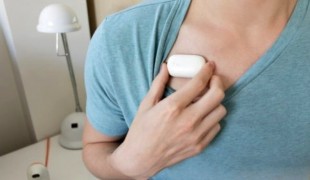- 15306
- 664
- 37
- 29
- 2
- Help Ukraine
About the solution
The device consists of a patch (a silicone membrane) that will help to detect an early heart attack. This represents the skin capillaries, and a drop of a solution of proteins albumin and FABP3 (a biomarker of heart attacks linked to cardiac ischemia) to simulate blood.
These heart attacks are sudden and appear to be asymptomatic. In these cases, doctors are unlikely to administer a crucial FABP3 blood test because of the lack of visible symptoms to warrant a diagnostic test.
Ankash created a cost-effective technique that can potentially be coupled with trans-cutaneous UV-protein quantification to non-invasively measure the amount of FABP3 in a patient's blood and alert him or her of a silent heart attack.
The technique involves frequently analysing the presence of FABP3 without puncturing the skin.
“FABP3 is one of the smallest proteins that can be present in blood, and is charged negatively (so it attracts to positive charges). I used these properties in this technique,” the inventor explained.
When a small potential of positive charge is applied to the model, FABP3 accumulates on dermal capillaries, which can then be detected by UV quantification, he said.
In this process, UV light is passed through the thin skin in which FABP3 is accumulated and a sensor detects the amount of protein there, based on the how much of the light was absorbed.
When positive electric potential is applied to a thin and translucent area of skin (the external ear), FABP3 is the only protein that attracts to the positive charge being the smallest and therefore the most sensitive protein that can be present in the blood. What follows next was the UV quantification process to determine the potential of a heart attack and consult the doctor beforehand, with immense potential to change the diagnosis method of cardiovascular disease.
This patch can be helpful for at-risk patients like diabetics, patients with abnormal cholesterol levels and other heart-related diseases.
The student was always passionate about science and aeronautics. He is now in the process of getting his invention patented. It took the student two years to invent this innovation.
"It will take one and half years to complete work on this invention. It is a huge process, and I will have access to the research labs at the Indian Institute of Science, Bengaluru too," says Manoj, in the process of patenting his invention.
The medical product is likely to surface in 2018 at a cost of Rs 900.
The inventor wants the government to promote his invention and not the private industry, who he feels will kill it since it is cost-effective.
Adapted from: http://bit.ly/2tnffpu
This solution shall not include mention to the use of drugs, chemicals or biologicals (including food); invasive devices; offensive, commercial or inherently dangerous content. This solution was not medically validated. Proceed with caution! If you have any doubts, please consult with a health professional.
DISCLAIMER: This story was written by someone who is not the author of the solution, therefore please be advised that, although it was written with the utmost respect for the innovation and the innovator, there can be some incorrect statements. If you find any errors please contact the patient Innovation team via info@patient-innovation.com
-
-
650
-
0
-
9622

Patient develops wearable for Asthma
VENTILATION
CAREGIVING
Asthma
Assistive Daily Life Device (to help ADL)
Treatment/Surgical device
App (Including when connected with wearable)
Pharma
Improving respiratory function
Promoting self-management
Manage Medication
Preserving Organ Function
To implement a diagnostic tool
Alleviating Allergies
To improve Treatment/Therapy
Preventing (Vaccination, Protection, Falls, Research/Mapping)
Caregiving Support
General and Family Medicine
Immuno-allergology
Pneumology
Australia
-
-
-
491
-
0
-
6888

Son develops early skin cancer detector device after mom gets ill
CAREGIVING
Skin Cancer
Melanoma
dermatitis
Treatment/Surgical device
AI algorithm
Skin redness (rash)
Itching (pruritus)
Dry skin
Skin lumps or growths
Skin ulcers or sores
Skin discoloration
To implement a diagnostic tool
To improve Treatment/Therapy
Preventing (Vaccination, Protection, Falls, Research/Mapping)
Caregiving Support
Dermatology
Medical Oncology
Israel
-
-
-
544
-
0
-
8795

Students invent smartphone case to administrate epinephrine
CAREGIVING
VENTILATION
Asthma
Allergic reaction (food, drugs, material/chemicals)
Treatment/Surgical device
Pharma
Fever
Nasal congestion
Dry cough
Skin redness (rash)
Itching (pruritus)
Skin blisters
Stridor/wheezing.
Improving respiratory function
Manage Medication
Alleviating Allergies
To improve Treatment/Therapy
Preventing (Vaccination, Protection, Falls, Research/Mapping)
General and Family Medicine
Immuno-allergology
Pneumology
United States
-
 en
en
katedaisy • Wed, 08/07/2019 - 09:00
I still have questions about this, the article is very good, it helps me now fireboy and watergirl